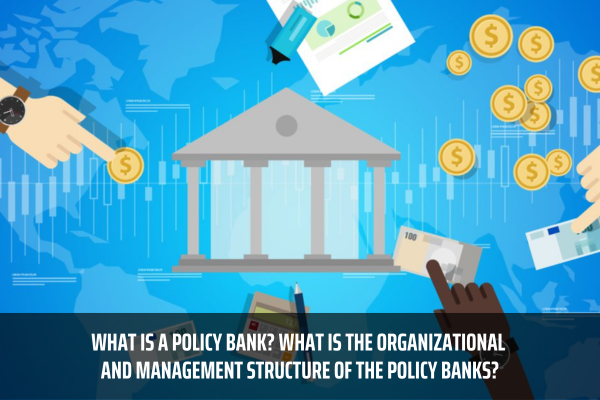What is a policy bank? What is the organizational and management structure of the policy banks in Vietnam under the Law on Credit Institutions 2024?
On January 18, 2024, at the 5th extraordinary session, the 15th National Assembly passed the Law on Credit Institutions 2024, effective from July 1, 2024.
What is a policy bank in Vietnam?
Pursuant to the provisions of Article 16 and Article 17 of the Law on Credit Institutions 2024, it is stipulated as follows:
Establishment, operation and state management of policy banks
1. Policy banks were established by the Prime Minister and operate for non-profit purposes to implement the State's socio-economic policies.
2. The Government regulates the activities of policy banks.
3. The Prime Minister and ministries and ministerial-level agencies perform state management functions according to their authority over the activities of the policy bank.
...
Owner and representative of the state owner of the policy bank
1. The State is the owner of the policy bank. The Government uniformly manages the implementation of tasks and powers of the state owner of the policy bank.
2. The Board of Directors is the direct representative of the state owner at the policy bank, performing the tasks and powers of the state owner according to the Government's regulations.
According to the above regulations, the State is the owner of the policy bank. The policy bank will be established by the Prime Minister and operate for non-profit purposes to implement the State's socio-economic policies.

What is a policy bank? What is the organizational and management structure of the policy banks in Vietnam under the Law on Credit Institutions 2024? (Image from the Internet)
What is the organizational and management structure of the policy banks in Vietnam?
Pursuant to Article 19 of the Law on Credit Institutions 2024 stipulates as follows:
Management and organizational structure of the policy bank
1. The organizational and management structure of the policy bank includes the Board of Directors, the Control Board, the General Director and other management structures according to the Government's regulations.
2. Policy banks are allowed to establish branches, transaction offices, transaction offices and other affiliated units according to the provisions of law.
Accordingly, the bank's organizational and management structure includes:
- Board of Directors
- Control Board
- General manager
- Other governance structures according to Government regulations
Contact in Article 19, Article 20, Article 21, Article 22 of the Law on Credit Institutions 2024 specifically stipulates the organizational and management structure of policy banks as follows:
(1) Board of Directors of the policy bank:
- The Board of Directors includes the Chairman and other members.
- The term of office of members of the Board of Directors shall not exceed 05 years.
- The Chairman of the Board of Directors is appointed and dismissed by the Prime Minister.
- Number, appointment and dismissal of members of the Board of Directors; The structure, tasks and powers of the Board of Directors are prescribed by the Government.
- The Board of Directors has a supporting department. The functions and tasks of the supporting department are prescribed by the Board of Directors.
(2) Control board of policy bank:
- The Supervisory Board includes the Head of the Board and other members.
- The term of office of members of the Supervisory Board shall not exceed 05 years.
- Number, appointment and dismissal of members of the Supervisory Board; The structure, tasks, and powers of the Supervisory Board are prescribed by the Government.
- The Supervisory Board has an internal audit department, which can use the policy bank's resources to carry out its tasks.
(3) General Director of the policy bank:
- The General Director is the legal representative, managing the daily operations of the policy bank.
- The term of office of the General Director shall not exceed 05 years.
- The General Director is appointed and dismissed by the Prime Minister.
- The appointment, dismissal, rights and obligations of the General Director are prescribed by the Government.
What are the capital sources of the Bank for Social Policies in Vietnam?
Pursuant to Article 4 of the Charter on organization and operation of the Bank for Social Policies issued together with Decision 16/2003/QD-TTg regulating the capital sources of the Bank for Social Policies coming from the following sources :
- Capital sources from the State budget:
+ Charter capital;
+ Lent capital for hunger elimination and poverty alleviation, job creation and the implementation of other social policies;
+ Capital partly deducted from the sources of increased revenues and/or saved expenditures of budget of various levels in order to increase lent capital sources in localities;
+ ODA capital allocated by the Government.
- Mobilized capital:
+ Interest deposits of domestic and foreign organizations and individuals;
+ Deposits of State-run credit institutions being equal to 2% of the balance of mobilized capital in Vietnam dong with interests paid under agreement;
+ Voluntary interest-free deposits of domestic and foreign organizations and individuals;
+ Bonds issued under the Government’s guarantee, deposit certificates and other valuable papers;
+ Savings of poor people.
- Capital borrowed from:
+ Financial or credit organizations at home and abroad;
+ Postal Savings, Vietnam Social Insurance;
+ The State Bank.
- Non-refundable capital voluntarily contributed by domestic and foreign individuals, economic organizations, financial and credit organizations, socio-political organizations, associations, societies and non-governmental organizations.
- Capital entrusted for preferential loans by local administrations, economic organizations, socio-political organizations, associations, societies, non-government organizations and individuals at home and abroad.
- Other capital sources.
Law on Credit Institutions 2024 comes into force from July 1, 2024, except for the provisions in Clause 3, Article 200 and Clause 15, Article 210 of the Law on Credit Institutions 2024, which come into force from January 1, 2025.
LawNet